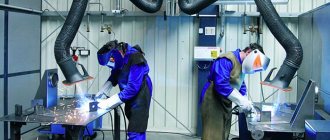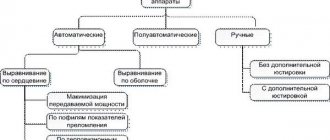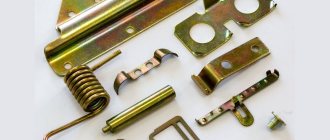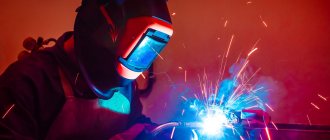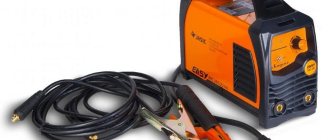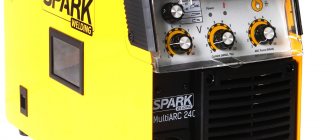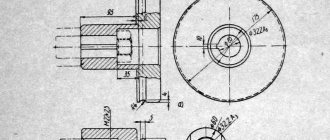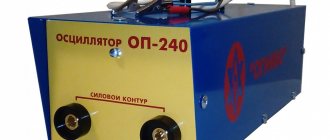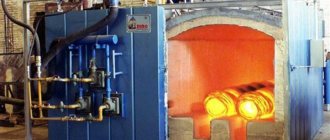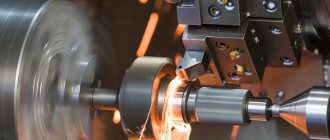Without exception, all welders working in production have a specially equipped workplace, which is also commonly called a welding station. It can be stationary or mobile and is equipped depending on the tasks assigned to the specialist.
- Stationary station equipment
- General requirements
Basic equipment
To fully equip a welding station, it is necessary to equip it with electrical equipment, additional equipment and auxiliary means:
- a current source for the formation of a welding arc, which is a welding transformer or inverter;
- current-carrying cables in a reliable braid that can withstand high current strength and constant mechanical stress.
- conductors must have appropriate fastening at the end for connection to terminals, electrode holders and ground;
- gas burners for working with gas welding equipment;
- fixtures and other tools for welding work: clamps, clamps, holders;
- welding table;
- protective equipment: heat-resistant suit, special gloves, welder’s mask, headdress with a lapel.
A distinctive feature of a mobile welding station is that it does not have any boundaries. This is explained by the fact that a specialist needs to constantly move to perform his duties within a certain area: construction site, welding shop, production site, etc.
It is worth paying attention to the fact that this classification relates exclusively to the organization of procedures, but does not in any way regulate the nature of the manipulations performed.
Workplace arrangement options
In practice, it is customary to distinguish between two types of welding stations. Stationary is mostly used for working with small-sized workpieces. The mobile one is in demand at large production sites, in the construction or laying of various types of pipelines.
Basic requirements for organizing a workplace for welding work:
- Good lighting should be provided in the area. The minimum value is 80 Lux. It is advisable to combine natural light and artificial light.
- All electrical equipment must be grounded.
- The base must be strong and solid. As a rule, this is concrete or brickwork.
- Work pockets should be provided at the workplace where documentation or graphic materials could be stored.
- Good ventilation must be provided.
- The working surface of the welding table must be made of steel or cast iron. Nearby there should be connectors for connecting the welding machine and additional equipment.
- There should be a rubber mat or a thick wooden shield under the specialist’s feet.
- To perform work in a sitting position, you need a dielectric chair made of non-flammable material.
If the workplace is set up outdoors, then you need a canopy that will well protect the welder and equipment from rain. In sunny weather, you can work in an open area, but protection from direct sunlight is often required. Then the canopy can be replaced with high shields.
Purpose of workplace organization
Proper placement of equipment and the creation of certain conditions for performing work contribute to the following:
- enterprise productivity increases;
- it is more convenient for the welder to do the work, therefore the quality of the result improves;
- the worker’s protection from passive harmful influences (gases, radiation) increases;
- workplace injuries are prevented;
- a favorable environment is created for the work of other employees whose activities are carried out next to the welder.
To achieve all these goals, efforts are being made to introduce a number of measures and technologies into the workplace that provide sufficient space and comfort for the welder, as well as protecting the health of both the specialist himself and those around him.
What is a welding post
A welding station is essentially a makeshift welder's office. Yes, there are no comfortable chairs, tables or jugs of water, but there is everything necessary to perform a complex of welding work. In other words, a welding station is a workspace where a welder can work comfortably and safely, and he always has consumables and other necessary equipment at hand.
The welding station must be equipped in compliance with all safety and labor protection requirements. This is a mandatory condition that allows specialists to maintain their health and get the most out of them. When setting up the post, special attention is paid to fire safety. But in order to achieve all the necessary conditions, you should study the specifics of different welding posts.
Depending on the equipment used, welding stations can be:
- Gas welding . The main distinguishing principle is that the energy obtained as a result of gas combustion in a special burner is used to melt metal blanks. Due to the specific nature of gas welding, it is important to equip a good ventilation system for organizing a work office. The surface of the desktop and the space around it must be made of non-combustible materials.
- Electric welding . Working with electric welding is no less dangerous than working with gas welding. In addition to good ventilation, effective protection of employees from electric shock is also necessary.
In any case, no matter what method of welding or cutting metal is used in a closed workspace, it is very important to carefully consider the arrangement of the ventilation system. In addition to the hood, supply systems are also installed for natural or forced supply of fresh air.
Depending on the needs, welding stations can be:
- Stationary . It is a limited space in a room, equipped specifically for welding metals. They are often equipped with rotary tables for convenience.
- Mobile . They are mobile structures that one person can carry or move within the work site. The best option in cases where welding of large structures is required. They can be located indoors (workshop, production site, shipbuilding dock, etc.) or in an open area (construction, creation of large-sized non-standard structures, etc.).
A stationary welding station is best suited for joining small and medium-sized metal workpieces. But for working with large-sized structures this is not the best option. A special cabin, which serves as the “walls” of such an area, is made of galvanized metal sheets. They are characterized by high resistance to high temperatures, as well as IR radiation.
A clear advantage of a mobile welding station is the fact that there is no need to create any special conditions for work. If necessary, protection from precipitation is provided by a canopy, and from wind - by side hard screens. If conditions permit, parts are welded without protection from the weather.
Tools and additional equipment are contained in the drawers of the tool cabinet, and artificial lighting (if required) is provided locally. In mobile posts, as in stationary ones, care should be taken to ground the equipment that is connected to the power supply network.
Requirements for premises for welding installations and welding stations
7.6.33. The premises and buildings of assembly and welding shops and areas with electric welding installations and welding stations located in them, as well as ventilation devices must meet the requirements of current regulatory documents.
7.6.34. For electric welding installations and welding stations intended for permanent electric welding work in buildings outside welding and assembly shops and areas, special ventilated rooms must be provided, fenced off with fire partitions of the 1st type, if they are located adjacent to rooms of categories A, B and C according to explosion and fire hazard, and type 2 in other cases. The area and volume of such premises and their ventilation systems must comply with the requirements of current sanitary rules and SNiP, taking into account the dimensions of welding equipment and welded products.
7.6.35. Welding stations may be located in explosion and fire hazardous areas only during the period of temporary electric welding work carried out in compliance with the requirements set out in the standard instructions for organizing the safe conduct of hot work at explosion and fire hazardous facilities, approved by the Gosgortekhnadzor of Russia.
7.6.36.In rooms for electric welding installations, passages of at least 0.8 m must be provided to ensure convenience and safety of welding work and delivery of products to the welding site and back.
7.6.37. The area of a separate room for electric welding installations must be at least 10 m2, and the area free of equipment and materials must be at least 3 m2 for each welding station.
7.6.38. Welding stations for systematically performing manual arc welding or shielded gas welding of small and medium-sized products directly in production shops in non-fire and non-explosive areas must be placed in special booths with walls made of fireproof material.
The depth of the cabin must be at least twice the length, and the width must be at least one and a half lengths of the products being welded, however, the area of the cabin must be at least 2´1.5 m. When installing a welding power source in the cabin, its dimensions must be increased accordingly. The height of the cabin walls must be at least 2 m, the gap between the walls and the floor is 50 mm, and when welding in shielding gases - 300 mm. In case of movement above the overhead crane cabin, its top must be covered with a mesh with cells no larger than 50´50 mm.
7.6.39. Work at welding stations during non-systematic manual arc welding, submerged arc welding and electroslag welding is allowed directly in fire-hazardous premises, provided that the work area is fenced with shields or curtains made of non-combustible materials with a height of at least 1.8 m.
7.6.40. When systematically welding products weighing more than 20 kg, electric welding installations must be equipped with appropriate lifting and transport devices to facilitate installation and transportation of the welded products.
7.6.41. Natural and artificial lighting of electric welding installations of assembly and welding shops, sections, workshops, individual welding stations (welding booths) and welding places must meet the requirements of SNiP 23-05-95 “Natural and artificial lighting. Design standards".
7.6.42. When manual welding with thickly coated electrodes, electroslag welding, submerged arc welding and automatic open arc welding, gas suction must be provided directly from the welding zone.
7.6.43. At welding stations during open arc and submerged arc welding inside tanks, closed cavities and structures, ventilation must be provided in accordance with the nature of the work performed. If necessary ventilation is not possible, a forced supply of clean air under the welder’s mask should be provided in an amount of 6-8 m3/h.
7.6.44. Canopies made of non-combustible materials must be built over portable and mobile welding installations located in the open air to protect the welder’s workplace and electric welding equipment from precipitation.
Sheds may not be built if the electrical equipment of the electric welding installation has a shell with a degree of protection corresponding to operating conditions in outdoor installations, and during rain and snowfall, electric welding work will stop.
7.6.33. The premises and buildings of assembly and welding shops and areas with electric welding installations and welding stations located in them, as well as ventilation devices must meet the requirements of current regulatory documents.
7.6.34. For electric welding installations and welding stations intended for permanent electric welding work in buildings outside welding and assembly shops and areas, special ventilated rooms must be provided, fenced off with fire partitions of the 1st type, if they are located adjacent to rooms of categories A, B and C according to explosion and fire hazard, and type 2 in other cases. The area and volume of such premises and their ventilation systems must comply with the requirements of current sanitary rules and SNiP, taking into account the dimensions of welding equipment and welded products.
7.6.35. Welding stations may be located in explosion and fire hazardous areas only during the period of temporary electric welding work carried out in compliance with the requirements set out in the standard instructions for organizing the safe conduct of hot work at explosion and fire hazardous facilities, approved by the Gosgortekhnadzor of Russia.
7.6.36.In rooms for electric welding installations, passages of at least 0.8 m must be provided to ensure convenience and safety of welding work and delivery of products to the welding site and back.
7.6.37. The area of a separate room for electric welding installations must be at least 10 m2, and the area free of equipment and materials must be at least 3 m2 for each welding station.
7.6.38. Welding stations for systematically performing manual arc welding or shielded gas welding of small and medium-sized products directly in production shops in non-fire and non-explosive areas must be placed in special booths with walls made of fireproof material.
The depth of the cabin must be at least twice the length, and the width must be at least one and a half lengths of the products being welded, however, the area of the cabin must be at least 2´1.5 m. When installing a welding power source in the cabin, its dimensions must be increased accordingly. The height of the cabin walls must be at least 2 m, the gap between the walls and the floor is 50 mm, and when welding in shielding gases - 300 mm. In case of movement above the overhead crane cabin, its top must be covered with a mesh with cells no larger than 50´50 mm.
7.6.39. Work at welding stations during non-systematic manual arc welding, submerged arc welding and electroslag welding is allowed directly in fire-hazardous premises, provided that the work area is fenced with shields or curtains made of non-combustible materials with a height of at least 1.8 m.
7.6.40. When systematically welding products weighing more than 20 kg, electric welding installations must be equipped with appropriate lifting and transport devices to facilitate installation and transportation of the welded products.
7.6.41. Natural and artificial lighting of electric welding installations of assembly and welding shops, sections, workshops, individual welding stations (welding booths) and welding places must meet the requirements of SNiP 23-05-95 “Natural and artificial lighting. Design standards".
7.6.42. When manual welding with thickly coated electrodes, electroslag welding, submerged arc welding and automatic open arc welding, gas suction must be provided directly from the welding zone.
7.6.43. At welding stations during open arc and submerged arc welding inside tanks, closed cavities and structures, ventilation must be provided in accordance with the nature of the work performed. If necessary ventilation is not possible, a forced supply of clean air under the welder’s mask should be provided in an amount of 6-8 m3/h.
7.6.44. Canopies made of non-combustible materials must be built over portable and mobile welding installations located in the open air to protect the welder’s workplace and electric welding equipment from precipitation.
Sheds may not be built if the electrical equipment of the electric welding installation has a shell with a degree of protection corresponding to operating conditions in outdoor installations, and during rain and snowfall, electric welding work will stop.
Types of welding stations
Stationary post
The classic design of a stationary welding station involves the installation of a special protective cabin without a canopy.
Requirements for organizing a stationary workplace:
- The area of the room along the internal perimeter must be at least three square meters.
- The surface of the walls is finished with non-combustible materials.
- The cabin frame can only be made of metal.
- The height of the work table depends on the method of performing the work. For a sitting position it is 60 cm, and for a standing position it is 90 cm. Ideally, if the structure can be lowered or raised depending on the situation.
- A tarpaulin canopy is hung at the entrance.
- The minimum permissible cabin height is 2 meters.
- The lower part of the walls is raised above the floor level to improve ventilation. The gap should be at least 25 cm.
- The working surface requires a metal or cast iron sheet with a total area of at least one square meter.
- The inside of the cabin is treated with a special compound in a light gray shade. It has high fire-resistant characteristics and absorbs ultraviolet radiation. This is necessary to prevent accidental ignition of the surface of the walls of the room.
Gas welding station
To organize a gas welding station, you will first need the appropriate equipment: an acetylene generator, burners and hoses for gas supply, oxygen cylinders and reducers.
A portable gas welding station is a trolley on which cylinders, gearboxes and all the necessary equipment are located. The cart is most often made of pipes, and the wheel axle is located at the center of gravity to make it easier to move and hold.
The gas welding station equipment consists of the following elements:
- table with metal top;
- hood. It is usually installed above the table or slightly to the side;
- sources of light.
Gas cylinders are located slightly away from the workbench to prevent hot splashes from getting on the gearboxes. Gas is supplied to the work site through hoses. Large enterprises often provide for gas supply through centralized pipelines.
According to existing standards, for safety reasons, the distance between the work table and cylinders with acetylene and oxygen must be at least 10 meters. The same footage (no less!) must be maintained between cylinders and any sources of open fire. In cases where you have to work in narrow or hard-to-reach places, a supply of fresh air is required.
Mobile post
A mobile welding station is necessary when performing work with large-sized structures. Often, such a workplace is located outdoors. Therefore, it requires additional equipment for protection from sunlight, wind and precipitation. The protection consists of a hinged canopy and folding rigid shields (screens) from the wind. To accommodate consumables, additional tools and small equipment, the mobile workplace is equipped with metalwork carts with drawers.
During welding work, harmful volatile substances are released in large quantities. They pose a health hazard to the specialist. However, ventilation is not required: the mobile welding station is located in an open area and the gases quickly evaporate.
But a local lighting system may be required. In conditions of poor natural light, an additional light source will be required. It is placed directly above the table on stands. Good lighting reduces eye strain, improves working conditions, which helps increase specialist productivity. Electrical equipment, including the welding machine itself, must be grounded in order to minimize the likelihood of electric shock to the welder.
It is necessary to take into account that when installing enclosing structures, a gap of about 50 cm should be left between the panels. This is necessary to ensure a sufficient flow of fresh air. The welder must have protective equipment - a special suit, shoes, mask, mittens and headgear. It is imperative to always have a working main tool - a holder. It must be reliable and safe, protect the welder’s hand from a source of high temperature, hold well and quickly release the electrode.
Proper equipment of a mobile welding station gives the welder the opportunity to work without discomfort and in completely safe conditions. This in turn brings:
- good final result of the work;
- reducing the time required to complete welding work;
- reducing the likelihood of specialist illness.
What is a welding post and what are its types?
A welding station is a kind of welder’s office with the entire complex of equipment, tools and consumables necessary for his work to ensure uninterrupted performance of welding work. That is, this is a welder’s workspace in which it is as comfortable and safe to work as possible.
If all work on arranging welding stations is carried out taking into account labor safety requirements, this will provide the foreman with the maximum level of safety when welding. At the same time, the level of fire resistance of the space will be maximum. But to achieve this, it is important to understand the specifics of different types of welding posts.
Stationary welding station.
Based on the type of equipment used in the work, welding stations are:
- Gas welding. The workroom for gas welding work is equipped taking into account the fact that the melting of metal in the process of organizing the joining of product edges in this case is based on the use of thermal energy from gas combustion in the burner. Therefore, the space must be equipped with the highest quality ventilation system, and surface finishing must be done with non-combustible materials.
- Electric welding. The workspace of an electric welder when working with electric welding is no less dangerous, but in this case it is important to pay more attention to ensuring a high level of human protection from electric shock.
On a note! Whatever type of equipment the master uses to perform welding work, the welding station must certainly be equipped with a high-quality exhaust hood and a supply ventilation system.
Stationary post for manual welding.
Based on the capabilities, welding stations are:
- Stationary. They look like an open-top cabin, which is raised above the level of the floor covering, are located indoors and can be equipped with a moving tabletop.
- Mobile. They are mobile structures that can be moved to another place for work without much difficulty. Mobile stations for welders are relevant for welding large-sized structures in spacious workshops or directly in the open air on a construction site.
In a stationary welding station, it is convenient to weld small and medium-sized parts, but it is not suitable for large components and metal structures. The cabin is made of rolled metal with a zinc-containing coating, resistant to high temperatures and infrared radiation.
A special feature of a mobile workplace is that there is no need to carry out special events or create special working conditions. The mobile welding station is protected from precipitation by means of a canopy, and from wind by means of screens.
Tools relevant for welding work are placed in special cabinets, and lighting of the space is provided by local light sources.
Important! When organizing a mobile welding station, it is important to ensure that absolutely all equipment is grounded.
Welding station equipment
Regardless of the functionality, be it a stationary or mobile welding station, the specialist’s place of work must fully comply with the following set of requirements:
- grounding of all energy-consuming devices is mandatory;
- good degree of illumination of the desktop. A combination of natural and artificial lighting is considered optimal;
- floors must be made of brick or concrete;
- the table top is made of cast iron or steel and is connected to ground;
- Drawers are provided for storing tools;
- in cases where sedentary work is required, a chair made of dielectric material is required;
- A rubber mat is spread under your feet.
When working in an open area, additional protection from sunlight, wind and precipitation will be required.
Stationary station equipment
A stationary workplace must meet a number of requirements:
- Such a workplace is made in the form of a cabin that does not have a roof. The total area of the allocated space should not be less than 3 square meters. The optimal height of the fences is 2 m. The entrance opening should be covered with a canopy made of fire-resistant tarpaulin.
- The lower part of the fence should be raised above the floor to a height of 25-30 cm.
- The material for the worktop tabletop can be steel or cast iron. The surface area is made no less than a square meter.
- It should be possible to adjust the height of the table so that the welder can change it to work while sitting (50-60 cm) or standing (90 cm).
- The perimeter walls are made of fire-resistant material. On the inside they are painted a light gray shade that absorbs ultraviolet radiation.
- It is necessary to provide a hood that would effectively remove combustion products. For effective air exchange, fresh ventilation will be required. According to safety requirements, the productivity of such a system is calculated to be no less than 40 cubic meters of air per hour.
- The standard lighting brightness is 60-80 lumens. It is ideal if it is possible to provide a combined illumination of the post: natural in combination with artificial.
All equipment connected to the power supply network must be grounded. In addition, one general switch is installed, which allows you to disconnect all equipment from the supply network at once.
Mobile post equipment
An excellent option for a production workshop or other large workspace, as well as when creating large-scale structures.
Primary requirements:
- Electric welding and additional equipment are combined on a mobile cart.
- The length of the power cable must be sufficient to move within the work area or facility.
- There is no need to install a ventilation system. On the street, combustion products of consumables are carried away as a result of the natural movement of air masses.
- The portable post is equipped with a canopy and protective shields that can be quickly assembled to protect from precipitation, wind or sun.
- In the same way, it is necessary to provide for the possibility of installing fences to protect bystanders from flashes of the welding arc.
- For ease of work, the welder must have a sufficient number of tool carts to store his equipment, additional equipment and equipment.
GENERAL INFORMATION ABOUT WELDING POSTS
When performing production operations, a worker or a team of workers is assigned a workplace in the form of a certain section of the production area, equipped, in accordance with the requirements of the technological process, with the appropriate equipment and necessary supplies. The electric welder's workplace is called a welding station, equipped with everything necessary to perform welding work. Welding stations can be stationary or mobile. Both the high productivity of welders and the stable quality of welds and joints largely depend on the proper organization of the workplace.
Workplaces for welders, depending on the work performed and the dimensions of the structures being welded, can be located in special welding booths or directly next to these products.
When welding small products, workplaces are equipped with welding booths (Fig. 21.1, 21.2) measuring 2000x2000 or 2000x3000 mm. The cabin frame is made of metal from steel pipes or rolled profiles. The walls of the cabins are made 1800-2000 mm high, for better ventilation not bringing them to the floor by 200-300 mm. Thin-sheet steel, asbestos-cement boards or other fireproof materials are used as wall materials. The walls are painted in light colors with fire-resistant paint - zinc or titanium white, yellow crown, etc., which absorb the ultraviolet rays of the welding arc well. Painting walls in darker colors is not recommended, as illumination deteriorates during breaks in the burning of the welding arc. The doorway in the cabin is covered with a tarpaulin curtain on rings, impregnated with a fire-resistant compound.
| Rice. 21.2. Layout of the welding cabin: 1 - arc power source; 2 - grounding; 3 — start of the arc power source; 4 - straight wire; 5 - return wire; 6 - table; 7 - ventilation; 8 - rug; 9 — electrodes; 10 — shield; 11 - holder; 12 - chair; 13 - waste box |
The floors in the cabins are made of fire-resistant material: brick, cement or concrete. Cabins should be well lit by daylight or artificial light and well ventilated. For this purpose, in addition to general ventilation, local suction is installed, absorbing harmful gases and welding dust directly from the zone of their formation. To assemble and weld parts, a welding table with a height of 500-600 mm for sitting work and about 900 mm for standing work is installed inside the cabin. The table cover with an area of about 1 m is made either from sheet steel with a thickness of 15-20 mm, or from a cast iron plate with a thickness of 20-25 mm, which is better, since the cast iron cover does not deform from heating. A steel bolt is welded to the bottom of the lid or to the table leg, which serves to secure the current supply wire from the welding current source and for the table grounding wire. There are slots on the side of the table for storing electrodes or filler wire. The drawer of the table stores tools, as well as technological documentation. For ease of work, a metal chair with a lifting screw seat made of non-conductive material (wood, plastic, etc.) is installed in the cabin. The welder should have a rubber mat under his feet.
For mechanized or automatic welding, a hardware box is additionally installed in the cabin. One of the main types of equipment for welding stations is arc power sources. They can be single-post or multi-post. Single station power supplies are usually placed at the workplace. When powering welding stations from multi-station sources, the welding current is distributed throughout the booths using current-carrying wires or buses. A switch or magnetic starter is installed in the cabin to turn on the welding current.
In addition, an important type of equipment for mechanized and automatic welding are semi-automatic and automatic arc welding machines, installed together with the auxiliary welding equipment and devices necessary for their successful operation. Schemes of welding stations for various types of arc welding are shown in Figure 21.3.
| Rice. 21.3. Equipment for an electric welder's workplace for mechanized welding in shielding gases: 1 — shielding gas cylinder; 2 — arc power source; 3 — semi-automatic burner; 4 — feeding mechanism; 5 - detail |
Arc welding uses both alternating and direct current. The sources of alternating current are welding transformers, and the direct current is welding rectifiers, converters and units. Currently, the industry produces various designs of all types of welding power sources.
Desktops
Considering that small metal parts are welded at stationary work stations, special tables are provided for convenience. Structurally, industrial workbenches are designed for work in a standing or sitting position. If the table is made independently, then you need to take into account that the optimal height for working while sitting is 60 cm, and for standing – 90 cm.
The table cover is made of sheet steel or cast iron 2 cm thick. The total surface area is at least 1 square meter. It is important that the table has drawers in which the welder can store electrodes and other consumables, tools and small equipment. If there are none, then you need to additionally acquire a special plumbing trolley.
Rubber mats should be placed under the table itself and along its perimeter to prevent electric shock to the welder. And one more small touch - a metal chair with a dielectric seat, which allows you to do part of the work in a sitting position.
Equipment for different types of welding
The organization of welding stations is associated, first of all, with the parameters of the equipment being used. The main ones are weight and requirements for the power supply network.
The welding station must be equipped not only with welding equipment and accessories for it. In addition, additional tools are required for trouble-free operation of welding machines, and, if necessary, minor repairs. For uninterrupted operation, you will also need a certain supply of consumables: various types of additives, flux in powder form or inert gas.
Technological maps, individual regulations, diagrams, drawings and other documentation will help you assemble a workstation more accurately. It is customary to distinguish two large groups of common equipment: electric and gas.
Stationary posts focused on the use of electrical equipment are often equipped with powerful AC or DC devices. Power supply often requires a connection to a three-phase network. The most popular additional equipment: AC transformers complete with or without rectifiers, generators, electric arc stabilizers.
When work is planned using gas (inert or active), the package includes cylinders containing hydrogen, argon, helium or other gas necessary for work. For gas welding, you will need cylinders with oxygen and working gas - acetylene or propane. The stationary gas welding station can be equipped with cylinders of different weights, starting from 10 liters.
The table can be very massive or small and compact. The only condition is that the area of the tabletop should not be less than 1 square meter. Vices and clamps will be its indispensable additions. In addition to this, additional equipment often includes various types of fasteners, pipe benders, rolling devices, etc. For mobile kits, small-sized equipment is used: gas welding machines with small cylinders, inverters and semi-automatic welding machines.
There are mobile installations located on the basis of automotive vehicles, including passenger cars. They are equipped with gasoline or diesel generators and are autonomous. Such posts are intended for field work. They are often found in natural disaster zones, on sections of highways after accidents; used in road and field work.
Basic requirements for arranging welding stations
Regardless of what equipment the post is equipped with, the fire safety requirements are almost the same. All their points are aimed at ensuring safe working conditions and making them as comfortable as possible. Primary requirements:
- The welder's place should be protected with shields or screens made of fireproof materials. the top should be left open;
- welding work using inert gases is allowed only in those booths where there is no top, the light opening between the fences and the base is 30 centimeters or more, and the walls of the fences are at least 2 meters;
- the inside of the post along the perimeter is sheathed with fireproof materials;
- The cabin area must be at least 4.5 square meters. This space is enough to accommodate welding equipment, accessories, various devices, systems for storing tools and consumables;
- when operating a plasma cutting machine, the height of the fences must be at least 2.2 meters, and the surface inside must be covered with fireproof materials;
- You should not install two welding machines inside one booth at once. And if this is really necessary, then a separating light-protective screen must be installed between them. It will prevent the possibility of a fire.
When arranging a welder’s workplace, the organization of a ventilation system is important. The production site foreman must check the ventilation performance of each station, since the safety of not only a specific welder, but also the work site as a whole directly depends on the efficiency of air exchange.
Practitioners advise:
- Ensure parallel operation of two exhaust systems at once: general and local.
- Local hoods are equipped with filters that purify the air from harmful aerosols and combustion products.
- When performing welding work in a protective environment, air is supplied dispersedly into the booth. In other cases, it may be pumped into the upper area of the cabin.
- It is desirable that the walls inside are matte. Then the welding glare will not be reflected.
If all the requirements for organizing the supply and exhaust ventilation system are met, then the workplace is ready for use. Before starting welding work, the specialist must wear protective clothing and a mask. Otherwise, he risks damaging his eyes and getting burns from hot metal drops.
In the open
The arrangement of a welder's workplace for manual arc welding in an open space uses shields and fences. This is applicable in cases of constant movement of a specialist around the workshop or during field work. Shields are placed to block visual contact between the electric arc and workers who work nearby.
Such fences have two posts on legs, between which there is a sheet of thin iron or slate. The height is the same as that of the cabin. It is installed so that it does not interfere with the welder in completing the task and closes him from others. The painting is done in a zebra style (black and yellow or black and white) so that the fences are clearly visible to others. This serves as a warning about welding work.
Requirements for welding stations
General requirements
Requirements for the organization of welding stations are based on compliance with safety regulations and ensuring comfort in carrying out work. It is important to ensure that all energy consuming installations are grounded. To place them, it is highly advisable to make a base of concrete or brickwork. The post must have everything necessary to store not only tools, but also documentation.
Briefly about the basic requirements. Ventilation is required. The table is made of steel or cast iron. The welder must stand on a rubber mat while working.
For cases where the welder works while sitting, it is necessary to provide a special chair with a non-conductive seat. It should be durable, but light and small so that it can be moved with one hand if necessary. Naturally, the seat should be comfortable, since sometimes a specialist has to work for several hours without a break.
Productive work is impossible without adequate lighting. The brightness should not be excessive, but at the same time, even small details should be well illuminated. As practice shows, 80 Lumens are enough to work. The light source should be placed directly above the table. If this is not possible, then it is permissible to place the lighting device in close proximity to the workplace.
Even if we are talking about multi-station welding, you still need a switch, by turning which you can turn off the electricity supply in an instant. This may be needed in an emergency and to de-energize the area at the end of the working day.
Making a welding station with your own hands
The welder’s workspace with a set of necessary equipment, tools, consumables and the welding machine itself is called a welding station. You can organize it yourself if you carefully study the standards and safety requirements for such offices.
When organizing a mobile welding station, additional devices will be required, since the entire complex of items, equipment and tools present in it must be movable.
The stationary type of welder’s workplace does not need to be moved, so when organizing it there is no need for supports on wheels, etc.
Regardless of the type of welding station, the work will require non-flammable materials to eliminate the risk of fire: for both permanent and temporary use of welding, it is important to provide the craftsman with safe working conditions.
Current tools and materials
When setting up a workplace for welding work, it is important to select a full range of tools and equipment that are relevant for the job.
Welding booth layout.
The list may change at the discretion of the welder, but there are positions that are extremely difficult to do without:
- welding machine;
- a device for storing filler materials and other types of auxiliary devices;
- constant power supply of electric current;
- comfortable landing place;
- switch for turning the voltage supply on and off;
- high-quality ventilation system, exhaust chamber;
- storage systems for small equipment: portable baskets, drawers, shelves, etc.;
- electric holder
The above elements, with rational planning of the workplace space, will take up relatively little space.
Equipping a welding station yourself must be carried out taking into account all safety requirements. The optimal length of the working space is 2 m, width – 2.5 m, height – 2 m. In no case should you create a closed upper part of the welding station.
To organize the walls, it is worth using thin steel or plywood impregnated with a fire-resistant solution.
To perform assembly and welding operations of metal parts inside the master’s office, it is important to install a comfortable table. The optimal parameters of the welding table are as follows: the height is 50-60 cm when working while sitting and about 90 cm when working while standing, and the area is about 100 cm2.
Steel bolts should be welded to the table, onto which the current-carrying wire from the welding current source, as well as the grounding wire of the work table, are attached.
On the side there are nests adapted for storing electrodes and filler materials. Drawers can be used to store small hand tools or technological documentation.
For comfort in the welding room, it is worth installing a chair whose seat is equipped with a lifting screw mechanism. The main thing is that the material of the chair is non-conductive. A rubber mat should be placed under the master’s feet.
The main type of equipment in welders' offices is considered to be single- or multi-station arc power sources.
Often, in the workspace, welders use single-station power sources, since in the case of power from multi-station sources, the welding current must be distributed throughout the cabins through the use of current-carrying wires or buses. Also, a switch must be installed in the cabin to turn the welding current on and off.
Step-by-step arrangement of a welding station
General view of a typical welding station.
Welding stations can be organized in a spacious garage, service station, construction site, etc.
In any case, all operations for their arrangement can be divided into the following stages:
- choosing a place to organize the master’s workspace, clearing it of foreign objects, cleaning;
- arrangement of the walls of the working area using steel or plywood impregnated with a fire-resistant composition;
- arrangement of a table with a table top and storage systems made of non-flammable material;
- providing access to a source of electricity for the operation of electrical equipment;
- organization of a reliable ventilation system;
- visual inspection of the work result before welding.
Important! The finishing of the work area must be carried out strictly following fire safety requirements. Therefore, avoid using flammable materials, low-quality storage systems and bulky pieces of furniture.
